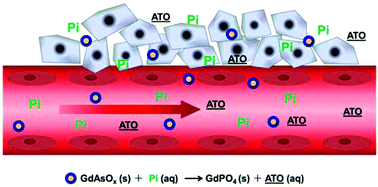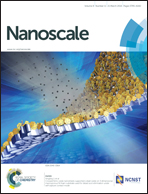Inorganic phosphate-triggered release of anti-cancer arsenic trioxide from a self-delivery system: an in vitro and in vivo study†
Abstract
On-demand drug delivery is becoming feasible via the design of either exogenous or endogenous stimulus-responsive drug delivery systems. Herein we report the development of gadolinium arsenite nanoparticles as a self-delivery platform to store, deliver and release arsenic trioxide (ATO, Trisenox), a clinical anti-cancer drug. Specifically, unloading of the small molecule drug is triggered by an endogenous stimulus: inorganic phosphate (Pi) in the blood, fluid, and soft or hard tissue. Kinetics in vitro demonstrated that ATO is released with high ON/OFF specificity and no leakage was observed in the silent state. The nanoparticles induced tumor cell apoptosis, and reduced cancer cell migration and invasion. Plasma pharmacokinetics verified extended retention time, but no obvious disturbance of phosphate balance. Therapeutic efficacy on a liver cancer xenograft mouse model was dramatically potentiated with reduced toxicity compared to the free drug. These results suggest a new drug delivery strategy which might be applied for ATO therapy on solid tumors.


 Please wait while we load your content...
Please wait while we load your content...